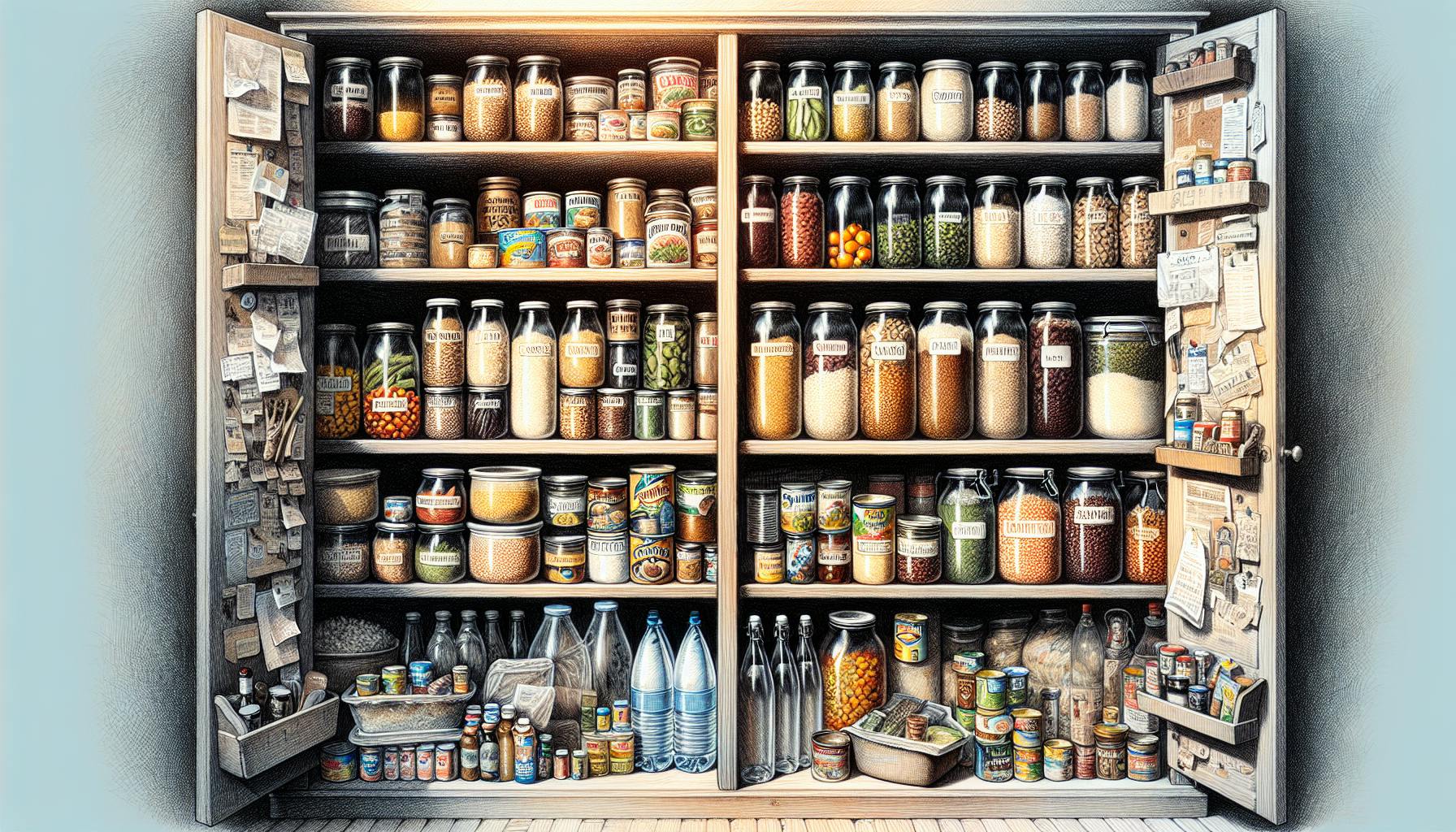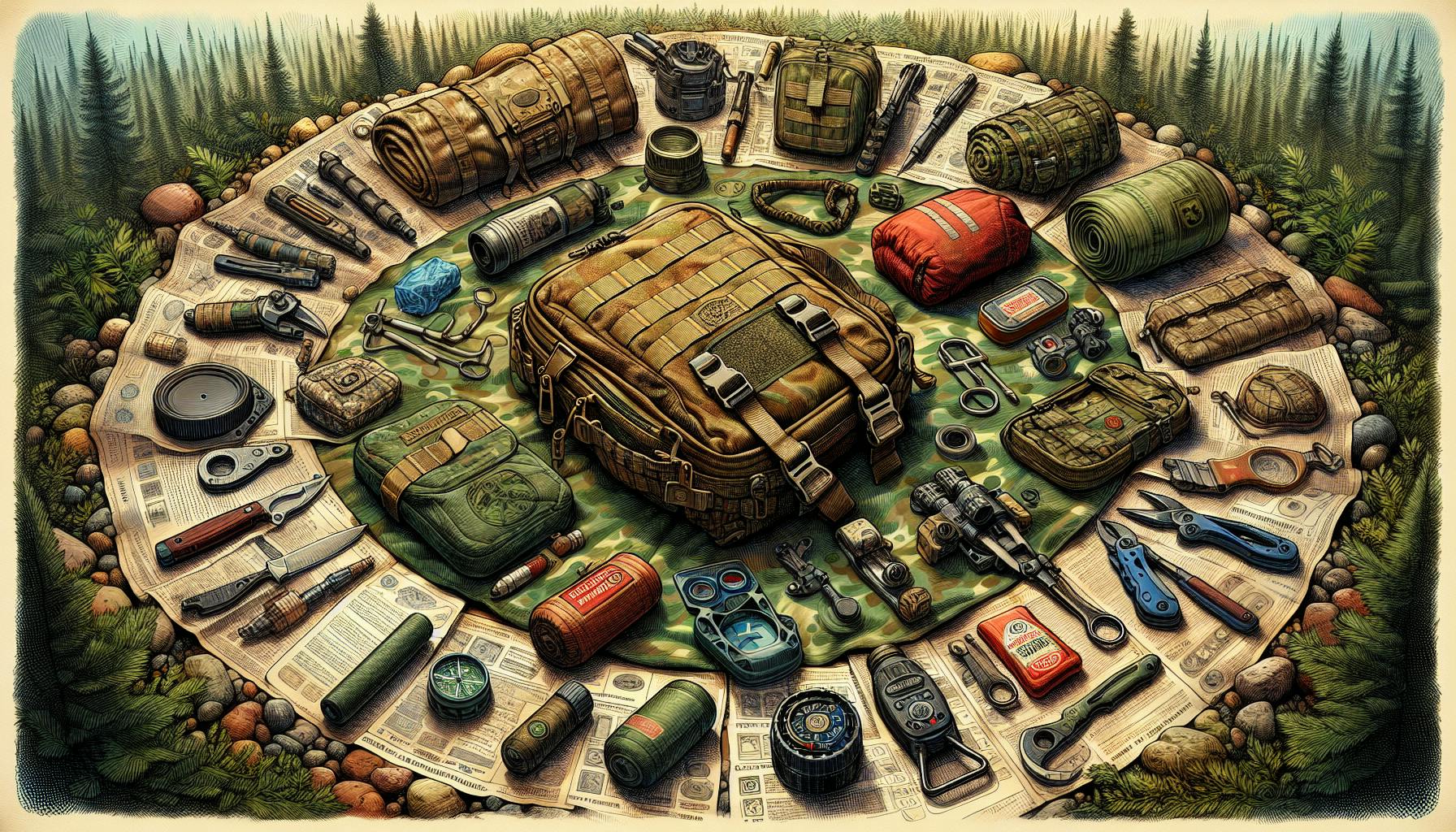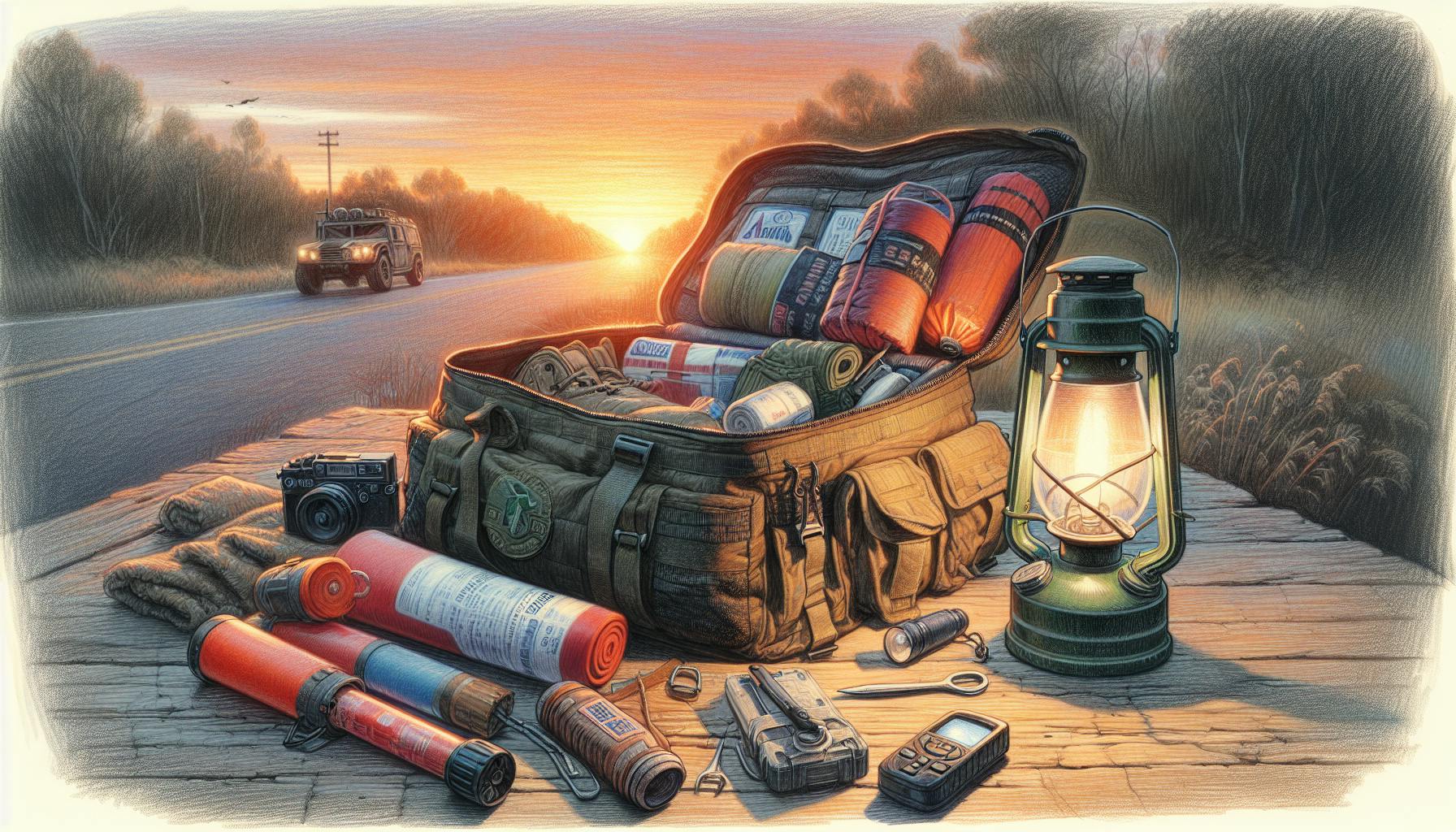When emergencies strike, having a well-stocked prepper first aid kit is crucial for proper care and survival.
This article will provide a comprehensive guide to building the perfect prepper first aid kit, equipping you with the essential medical supplies and knowledge needed to respond effectively in crisis scenarios.
You'll learn the key components every prepper first aid kit should contain, how to customize your kit for specific needs and environments, as well as discover expert recommendations for the best commercially available kits to complement your own.
Preparing for Emergencies with a Prepper First Aid Kit
A prepper first aid kit is a collection of medical supplies designed specifically for emergency and survival situations. When professional medical care is limited or unavailable, having the right supplies on hand can help treat injuries and prevent infections. These kits prioritize portability, durability, and including the essentials for wound care.
Understanding the Prepper First Aid Kit
Prepper first aid kits differ from standard kits in their purpose and contents. Since they are focused on emergency preparedness, key factors include:
-
Portability: Supplies must be lightweight and packable to ensure they can be easily transported if bugging out. Compact kits for hiking or vehicles are ideal.
-
Durability: Packaging should be impact-resistant and waterproof to withstand rough handling.
-
Trauma basics: Bandages, gauze, tourniquets, and wound closure items treat injuries from accidents or attacks.
-
Infection prevention: Antiseptics, antibiotics, anti-inflammatories aid recovery and prevent complications.
Having these medical basics helps manage health issues when professional care is inaccessible after a disaster or societal disruption.
The Target Audience for Prepper First Aid Kits
While useful for anyone focused on emergency preparedness, common target audiences include:
-
Outdoor enthusiasts who need supplies for remote activities like hiking, camping, or hunting trips.
-
Survivalists who prioritize self-reliance skills and equipment.
-
Homesteaders in rural areas far from medical facilities.
-
Disaster preppers creating stockpiles for events like earthquakes, floods, or electrical grid failure.
For these groups, having adequate medical capacity separate from the healthcare system is a crucial component of their preparedness strategy.
Essential Considerations for a Prepper First Aid Kit
When assembling the contents for your prepper first aid kit, key considerations include:
-
Compact size: Lightweight supplies that pack down small enough for bug out bags. Durable hard cases organize items.
-
Quick access: Well-labeled compartments, pouches, or sections allow rapid identification and use of gear.
-
Medical basics: Sterile gauze, bandages, antibiotic ointment, medical tape, trauma shears, tourniquets, wound closure items.
-
Regional risks: Account for likely local threats - extreme heat, cold, venomous wildlife, etc. Include appropriate medications.
Tailoring your kit this way ensures you have portable, organized medical capacity to handle likely emergencies in your area if the grid goes down.
Essential Components of the Best Prepper First Aid Kit
A comprehensive prepper first aid kit is a critical component of any emergency preparedness plan. Having the right medical supplies on hand can help treat injuries and illnesses when professional medical care is delayed or unavailable. This section outlines some of the most essential items to include in your survival medical kit.
Basic Wound Care and Bandage Selection
Stocking a variety of bandages ensures you can treat minor to severe wounds. Recommended items include:
- Sterile gauze pads and rolls - apply direct pressure to wounds or use for padding
- Adhesive bandages - protect minor cuts and abrasions
- Elastic wraps - secure dressings and splints
- Butterfly closures - hold deep cuts closed
- Trauma pads - absorb heavy bleeding
- Medical tape - secure dressings
- Latex gloves - protect against infection
- Antibiotic ointment - prevent infection in wounds
- Alcohol wipes - disinfect wounds and skin
Instruments and Tools for Emergency Response
Having basic medical instruments helps assess patients and assists in treatment:
- Trauma shears - cut away clothing
- Tweezers - remove debris/splinters
- Safety pins - secure bandages
- Digital thermometer - take temperature
- Penlight - assess eyes/throat
- Splinting materials - stabilize injuries
Medications and Survival Medical Kit Antibiotics
Include both OTC and prescription meds:
- Pain relievers - reduce pain and fever
- Anti-inflammatories - decrease inflammation
- Antihistamines - treat allergic reactions
- Antacids - alleviate heartburn/indigestion
- Loperamide - control diarrhea
- Antibiotics - combat infections if SHTF
Customize your prepper first aid kit based on your medical needs, skill level, and likely emergency scenarios. Maintain and resupply it regularly so it's equipped to handle a wide range of medical situations when SHTF.
Customizing Your Prepper First Aid Kit for Specific Needs
A prepper first aid kit is essential for emergency preparedness. However, a one-size-fits-all approach may not address all potential needs. Customizing your medical supplies allows you to tailor your kit to your specific situation.
Adjusting Supplies to Your Medical Skill Level
Consider your own first aid training and knowledge when stocking your kit. Those with wilderness first aid certification can include more advanced tools. However, basic kits should focus on essentials like bandages, gauze, ointments, and medications. Being realistic about your skill level ensures you can properly utilize the medical gear.
Calculating Group Size and Duration for Kit Contents
Determine how many people are in your group and the likely duration during an emergency when stocking supplies. Recommended basic contents per person include:
- Bandages and gauze
- Antibiotic ointment
- Anti-diarrheal medication
- Pain relievers
Then multiply by each group member and the estimated days without access to additional supplies. Surplus medical materials are wise in case of unexpected needs.
Tailoring Kits to Environment and Regional Risks
Customize your medical preparedness supplies based on your climate and potential regional hazards. Those in cold regions may need items like hand warmers, while those in hot areas should have electrolyte replacements. Remote locations may require satellite phones or location beacons. Research likely risks in your area like earthquakes, storms, or civil unrest when deciding on specialized gear.
The exact contents will vary, but adjusting your prepper first aid kit to your situation helps ensure you have what's needed when it counts. Evaluate all factors from skills to group size, environment, and potential emergencies when tailoring your critical supplies.
sbb-itb-b932644
Optimizing Your Prepper First Aid Kit for Portability and Accessibility
Assembling a well-stocked prepper first aid kit is crucial for emergency preparedness. However, optimizing your kit for portability and accessibility is equally important. When disaster strikes, you need to be able to quickly access your medical supplies on-the-go.
Here are key considerations when putting together a survival first aid kit that you can depend on in any situation:
Compact First Aid Kit for Hiking and Travel
-
Prioritize compact, lightweight supplies that take up minimal space, like small bandages, gauze rolls, antibiotic ointments, etc.
-
Use a durable, weather-resistant bag or case with multiple compartments to organize items efficiently.
-
Pack only essential medical gear to treat basic wounds, pain relief, infections - customize based on likely emergency needs.
-
Opt for travel-size packets of ointments, tablets over bulk containers to minimize weight.
Ensuring Waterproofing and Durability
-
Enclose first aid contents in waterproof plastic bags or dry sacks as an extra shield against moisture.
-
Choose a sturdy nylon or canvas bag that can withstand bumps and drops during transport.
-
Frequently inspect kit for damage and replace worn bags, cases or damaged gear as needed.
Maintaining Your Kit: Expiration and Replenishment
-
Create an inventory list of all medical items and expiration dates for easy tracking.
-
Set reminders to check supplies and replace expired or low inventory every 6-12 months.
-
Consider adding small notepads to log usage, inventory checks, replenishment dates.
Keeping your prepper first aid kit organized, lightweight and durable ensures that critical medical supplies are protected and within reach whenever an emergency strikes.
Evaluating Prepper First Aid Kits: Reviews and Recommendations
When building a comprehensive prepper first aid kit, reviews can provide valuable insights into the reliability, quality, and practicality of different products. Analyzing feedback from other preppers allows you to make informed decisions when selecting supplies.
Analyzing Prepper First Aid Kit Reviews
Reviews highlight real-world experiences with using prepper medical kits in emergency situations. Look for kits with consistently positive reviews across criteria like:
- Comprehensiveness - Does the kit contain the expected medical essentials for wound care, infection prevention, etc?
- Portability - Is the kit lightweight and compact enough for convenient transport?
- Durability - Do the materials, storage containers, and packaging withstand rough handling?
- Ease of use - Are the contents well-organized and clearly labeled for quick access when needed?
- Adaptability - Can the kit be customized to meet specific needs like adding prescription medications?
Kits with 4+ star reviews tend to meet preppers' expectations across these criteria.
Criteria for the Best Prepper First Aid Kit
Beyond positive reviews, the best prepper first aid kits excel in these key areas:
- Supplies - At minimum, the kit should include bandages, gauze, wraps, antiseptics, latex gloves, trauma shears, instant cold packs, and basic medications.
- Portability - Choose a durable, compact kit in a bag or case with handles for easy transport. Weight should stay under 25 pounds.
- Customization - The kit should have room to include personal medications and additional supplies tailored to likely risks.
- Water resistance - Ensure the kit is made of water-resistant materials to protect contents in wet conditions.
- Expiration tracking - The kit should make it easy to monitor and replace expired medical supplies.
Following prepper first aid kit reviews can help narrow down products that meet these standards.
Top Picks: Best Prepper First Aid Kit Selections
Based on consistently positive feedback for meeting prepper's needs, top-rated kits include:
- Surviveware Large First Aid Kit - Very comprehensive, customizable kit made for rugged use with 100+ medical supplies. Fits advanced prepper requirements.
- Be Smart Get Prepared First Aid Kit - Affordable kit packed with 70 essentials, well-organized and labeled for quick response. Great for basic prep needs.
- CVLIFE Compact Lightweight Tactical First Aid Kit - Ultra portable, durable kit focused on trauma injuries. Fits into a pouch for hiking/camping.
While reviews provide confidence in reliability, always inspect your own kit regularly for supply expiration and restock needs unique to your situation. Following usage guidelines and rotating inventory will ensure you have an effective prepper first aid kit ready for emergencies.
Building a Comprehensive Prepper First Aid Kit List
A well-stocked first aid kit is an essential part of any prepper's supplies. When an emergency strikes, quick access to basic medical supplies can make all the difference. This comprehensive guide covers everything you need to build a prepper first aid kit tailored to your situation.
Survival Medical Kit List: The Fundamentals
Every survival medical kit should contain basic wound care and infection prevention items:
- Sterile gauze pads and rolls in multiple sizes
- Adhesive bandages
- Roller bandages and elastic wraps
- Antiseptic ointments and wipes
- Nitrile gloves
- Trauma shears
- Tweezers
These supplies allow you to clean and dress cuts, scrapes, burns and other common injuries. Having materials to make arm slings, splints and tourniquets is also vital.
Advanced Items for the Prepper First Aid Kit List
Consider adding more advanced gear for serious trauma:
- Tourniquets to stop bleeding from limb injuries
- Chest seals for penetrating wounds
- Hemostatic agents to quickly clot bleeding
- Nasopharyngeal airways for maintaining breathing
- Decompression needles for collapsed lungs
Include any personal medications, prescription eyeglasses, medical devices, or special wound care items you need.
Custom Additions: Personalizing Your First Aid Kit
Tailor your prepper first aid kit to likely risks in your area and personal medical needs. Those prone to allergies may pack epinephrine injectors. Diabetics need glucose monitoring equipment. Areas prone to snake bites should have antivenom on hand.
No two medical kits are alike - customize yours to handle the emergencies you're most likely to face. Stay safe out there!
Conclusion: Ensuring Preparedness with Your Prepper First Aid Kit
Having a well-stocked and comprehensive prepper first aid kit is an essential part of emergency preparedness. By including all of the necessary medical supplies and medications, you can treat injuries and illnesses effectively when professional medical care is not available.
When building your prepper first aid kit, focus on the basics - wound care, infection control, pain management, and tools for minor procedures. Stock gauze, bandages, antibiotic ointment, medical tape, trauma shears, tweezers, over-the-counter pain relievers, and other fundamental treatment items. Don't forget personal protective equipment like gloves and masks as well.
Customize your kit based on your family's unique needs, skill level, climate, and likely emergency scenarios. Consider adding prescription medications, survival medical kit antibiotics, and items for wilderness first aid if relevant. Invest in high-quality gear that will hold up over time and replace expired contents annually.
With an organized, well-equipped prepper first aid kit, you can handle medical situations effectively when SHTF. Stay safe and ensure your family's health by making emergency preparedness a priority.


